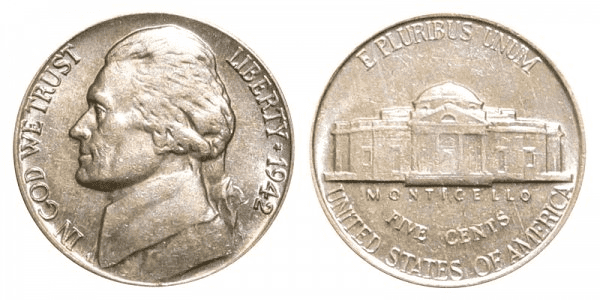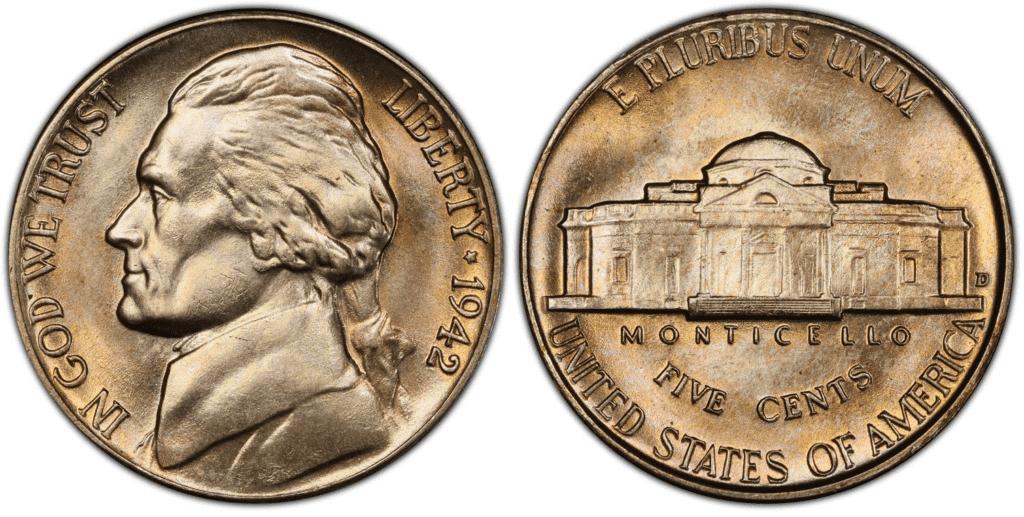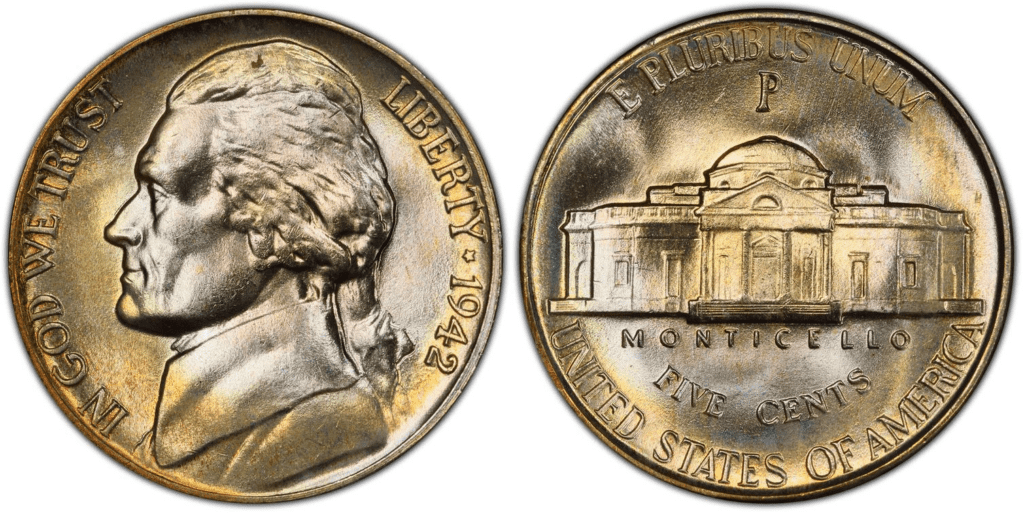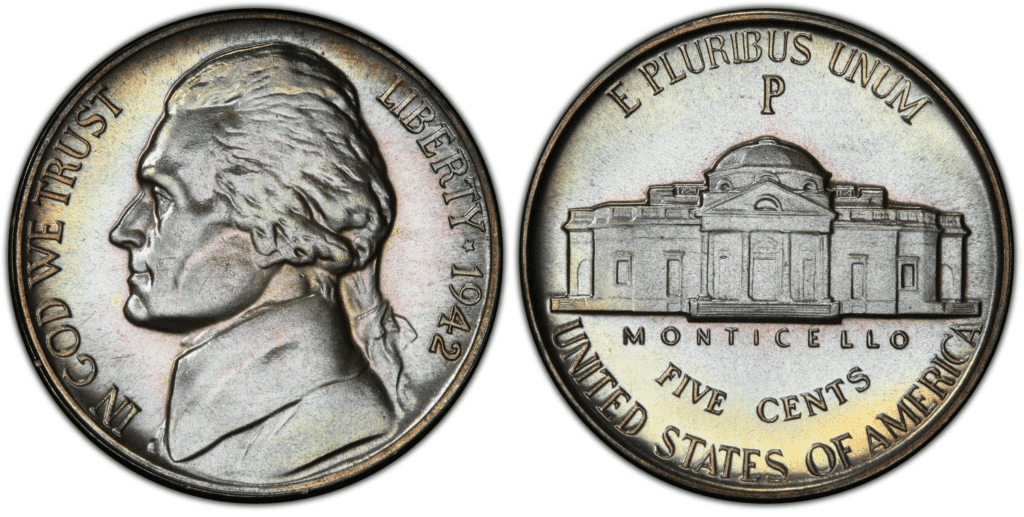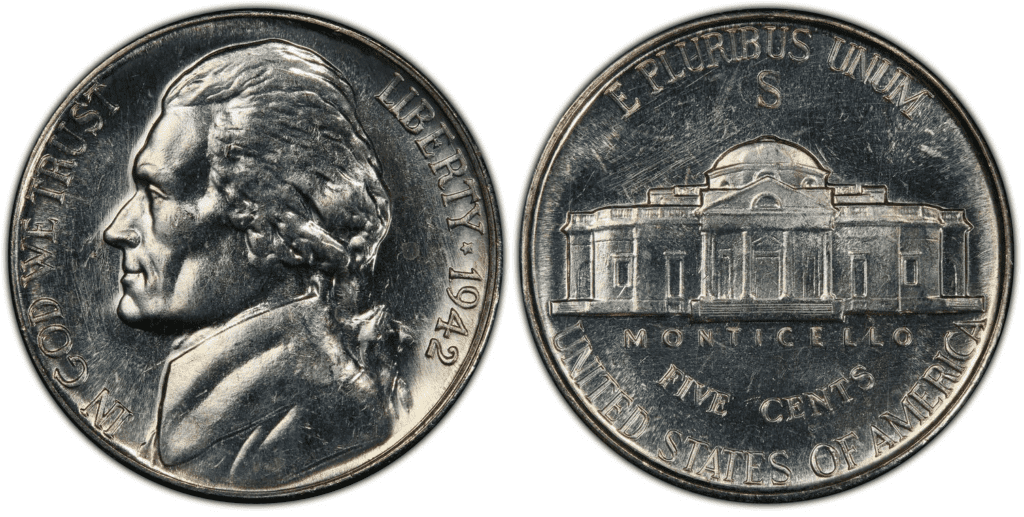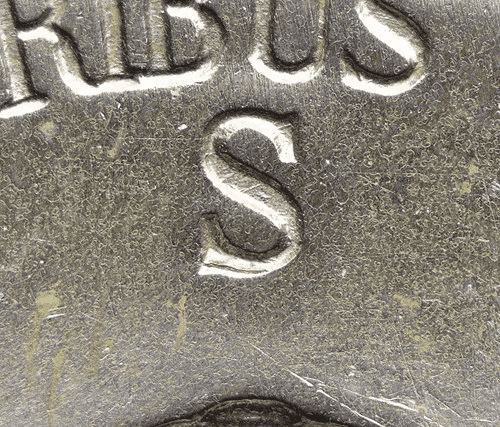What Is the 1942 Jefferson Nickel Made Of?
1942 was the year when the war broke out, and the United States was dragged into the conflict. As a result, the demand for copper increased since copper is an essential raw material in making weapons.
At the start of 1942, the Jefferson nickel was made of 75% copper and 25% nickel. Congress asked the US Mint to change the composition since copper is needed on the battlefield. By the middle of 1942, the Jefferson nickel’s composition was changed to 56% copper, 35% silver, and 9% manganese.
The 1942 Jefferson nickel is made of 75% copper and 25% nickel. It has a plain edge, a weight of 5 grams, a diameter of 21.20 millimeters, and a value of 5 cents.
The 1942 nickel was later known as the wartime nickel. The new composition would last until 1945 when the war ended.
Felix Schlag designed the original version of the Jefferson nickel. On the obverse, you’ll find the image of Thomas Jefferson, the third President of the United States and one of its Founding Fathers.
Image source: USA Coin Book
The obverse bears the following inscriptions:
- IN GOD WE TRUST
- LIBERTY
- 1942
On the reverse side, you’ll find Monticello, the mansion owned by Jefferson. It was known to be designed and built by the president himself.
Inscriptions include the following:
- E PLURIBUS UNUM
- MONTICELLO
- FIVE CENTS
- UNITED STATES OF AMERICA
The design of Schlag was used for the Jefferson nickel from 1938 to 2004. In 2005, it was replaced by a design made by Joe Fitzgerald, which was immediately replaced by Jamie Franki’s design in 2006.
1942 Jefferson Nickel Varieties
The 1942 Jefferson nickel has more varieties than other usual series of nickels. This is primarily due to the US going to war.
Here’s how the nickel 1942 Jefferson nickel varieties compare with each other:
| Variety | Mint Center | Mintage |
| 1942-D Jefferson Cupronickel Nickel | Denver | 13,938,000 |
| 1942-S Jefferson Cupronickel Nickel | San Francisco | 32,900,000 |
| 1942-P Jefferson Cupronickel Nickel (Type 1) | Philadelphia | 49,789,000 |
| 1942-P Jefferson Silver Nickel (Type 2) | Philadelphia | 57,873,000 |
| 1942-P Jefferson Silver Nickel (Type 2) Proof | Philadelphia | 27,600 |
| Total | 154,527,600 |
Aside from the standard-issued nickels, some error coins were produced in 1942. More about these error coins later.
For now, take a look at the different 1942 Jefferson nickels to learn more:
1942 D Jefferson Nickel
Edge: Smooth
Mint Mark: D
Place of minting: Denver
Year of minting: 1942
Face Value: $0.05 (five cents)
Price: $0.22 to $31 (circulated condition)
Quantity produced: 13,938,000
Designer: Felix Schlag
Composition: 75% Copper and 25% Nickel
Mass: 5 grams
Diameter: 21.21 mm
Thickness: 1.95 mm

photo source: PCGS
1942 is a key date in the history of US coinage. One primary reason was that the war caused the US Mint to reduce production. Because of this, it would be difficult to find 1942-D nickels in uncirculated condition.
The 1942-D nickels are considered to be among the most expensive coins in circulated condition. A circulated 1942-D 5-cent coin can easily reach a price of around $30.
1942 P Jefferson Nickel (Type 1)
Edge: Smooth
Mint Mark: none
Place of minting: Philadelphia
Year of minting: 1942
Face Value: $0.05 (five cents)
Price: $0.11 to $4.52 (circulated condition)
Quantity produced: 49,789,000
Designer: Felix Schlag
Composition: 75% Copper and 25% Nickel
Mass: 5 grams
Diameter: 21.21 mm
Thickness: 1.95 mm

photo source: PCGS
At the end of 1942, the Philadelphia Mint produced more than 49 million nickels. The type 1 1942-P nickel has the pre-war composition of 75% copper and 25% nickel.
You should find high-grade 1942-P type 1 nickel coins with relative ease. price may range from $0.11 to $4.52.
1942 P Jefferson Nickel (Type 2)
Edge: Smooth
Mint Mark: none
Place of minting: Philadelphia
Year of minting: 1942
Face Value: $0.05 (five cents)
Price: $1.66 to $8.41 (circulated condition)
Quantity produced: 57,873,000
Designer: Felix Schlag
Composition: 75% Copper and 25% Nickel
Mass: 5 grams
Diameter: 21.21 mm
Thickness: 1.95 mm

photo source: PCGS
In the middle of 1942, the US Mint needed to change the nickel composition to help win the war abroad. As a result, the type 2 1942 nickel has a decreased amount of copper with an addition of silver and manganese.
Thus, in 1942, two versions of nickels struck in Philadelphia. To differentiate the two types of nickels, the Philadelphia Mint added a big P mint mark on the coin’s reverse side.
Perhaps, the one big problem with the new silver coin is that they turned somewhat greenish after quite some time in circulation. Despite this problem, the US Mint decided to produce these silver coins up until the war was over in 1945.
The price of the 1942-P nickel may range from $1.66 to $8.41.
1942 P Jefferson Nickel Type 1 (Proof)
Edge: Smooth
Mint Mark: none
Place of minting: Philadelphia
Year of minting: 1942
Face Value: $0.05 (five cents)
Price: $30 to $100 (average condition)
Quantity produced: 29,600
Designer: Felix Schlag
Composition: 75% Copper and 25% Nickel
Mass: 5 grams
Diameter: 21.21 mm
Thickness: 1.95 mm

photo source: PCGS
The Philadelphia Mint produced two types of proof coins in 1942. The type-1-proof coins were made of copper and nickel. There were more than 29 thousand of them. Proof coins are made for collectors, and they are not intended for circulation. Aside from that, it takes more time and effort to produce proof coins. Thus, the mintage figure is significantly lower than other varieties.
1942 P Jefferson Nickel Type 2 (Proof)
Edge: Smooth
Mint Mark: none
Place of minting: Philadelphia
Year of minting: 1942
Face Value: $0.05 (five cents)
Price: $30 to $150 (average condition)
Quantity produced: 27,600
Designer: Felix Schlag
Composition: 56% Copper, 35% Silver, and 9% Manganese
Mass: 5 grams
Diameter: 21.21 mm
Thickness: 1.95 mm

photo source: PCGS
The 1942-P type 2 proof nickel coins were made of copper, silver, and manganese. You should be able to quickly differentiate type 2 from type 1 by looking at the mint mark. The silver type 2 nickel has a big P mint mark on the reverse side of the coin. About 27 thousand type-2 proof nickel coins were produced in 1942.
1942 S Jefferson Nickel
Edge: Smooth
Mint Mark: S
Place of minting: San Francisco
Year of minting: 1942
Face Value: $0.05 (five cents)
Price: $1.66 to $8.41 (circulated condition)
Quantity produced: 32,900,000
Designer: Felix Schlag
Composition: 56% Copper, 35% Silver, and 9% Manganese
Mass: 5 grams
Diameter: 21.21 mm
Thickness: 1.95 mm

photo source: PCGS
The San Francisco Mint produced more than 32 million silver 1942 nickels. Price may range from $1.66 to $8.41.This Mint didn’t produce nickels with the pre-war composition. They produced all nickels with silver in them. Because the silver-copper-manganese alloy is softer, the strike quality is much more detailed, which has prolonged the die’s life.
Thus, for the 1942-S nickels, you will find proof-like types that make the coin look more amazing than its usual appearance. The downside of the new silver coin was that they easily lost their luster and it eventually gained a darker color.
List Of 1942 Jefferson Nickel Errors
There were more than 150 million Jefferson nickels produced in 1942. With a massive mintage figure like this, it is not difficult to imagine how some of the coins issued might have been made with errors.
True enough, there were error coins in the 1942 Jefferson nickel series.
The first example is the S over S error. This happens when the mintmark is punched twice, and the mintmark creates a doubling illusion. Here’s what the 1942 Jefferson nickel with S/S error looks like:
Image source: NGC
There are even times when the S mintmark was punched to the planchet three times. Here’s an example:
Image source: NGC
Repunched mintmarks aren’t just a problem in the San Francisco Mint. There are nickels from the Denver mint that show this error coin. Here’s an example:
Image source: PCGS
Another error is called the DDO or doubled die obverse. If the error is found on the reverse, it’s called DDR. DDO or DDR happens when the die strikes the planchet twice. This results in a doubling effect on some of the engraved elements.
Here’s an example of a DDO error on a 1942 nickel:
Image source: NGC
Doubling is most obvious on the nose, face, “GOD,” and “1942.” While DDO is something the US Mint doesn’t like to happen, it is among the most valuable error types. The more prominent the error, the higher the coin’s value becomes.
How Much Is The 1942 Jefferson Nickel Worth Today?
The 1942 Jefferson nickel has a face value of 5 cents. The cupronickel variety has a melt value of $0.0672, while the silver variety has a melt value of $1.3779.
Yes, the face and melt values aren’t that big, but you can be confident that it has a higher numismatic value. Here’s a 1942 Jefferson Nickel value chart to help you better understand how much these coins can be:
| Coin | Condition | Grade | Mintage | Value |
| 1942 D Jefferson Nickel | Good to About Uncirculated | G-4 to AU-58 | 13,938,000 | $0.22 to $5.70 |
| 1942 D Jefferson Nickel | Select Uncirculated to Superb Gem Uncirculated | MS-63 to MS 67 | 13,938,000 | $20 to $360 |
| 1942 D Jefferson Nickel | Uncirculated to Superb Gem Uncirculated – Full Step | MS-63 to MS 68
|
13,938,000 | $112 to $4,320 |
| 1942 S Jefferson Nickel | Good to About Uncirculated | G-4 to AU-58 | 32,900,000 | $1.66 to $8.41 |
| 1942 S Jefferson Nickel | Select Uncirculated to Superb Gem Uncirculated | MS-63 to MS-68 | 32,900,000 | $20 to $1,380 |
| 1942 S Jefferson Nickel | Superb Gem Uncirculated – Prooflike | MS-67
|
32,900,000 | $228 |
| 1942 S Jefferson Nickel | Superb Gem Uncirculated – Full Step | MS-67
|
32,900,000 | $336 to $1,020 |
| 1942 P Jefferson Nickel (Type 1) | Good to About Uncirculated | G-4 to AU-58 | 49,789,000 | $0.11 to $1.42 |
| 1942 P Jefferson Nickel (Type 1) | Uncirculated to Superb Gem Uncirculated | MS-63 to MS 68 | 49,789,000 | $18 to $633 |
| 1942 P Jefferson Nickel (Type 1) | Uncirculated to Superb Gem Uncirculated – Full Step | MS-63 to MS 67
|
49,789,000 | $16 to $3,600 |
| 1942 P Jefferson Nickel (Type 2) | Good to About Uncirculated | G-4 to AU-58 | 57,873,000 | $1.66 to $$4.10 |
| 1942 P Jefferson Nickel (Type 2) | Choice Uncirculated to Superb Gem Uncirculated | MS-64 to MS 67 | 57,873,000 | $18 to $3,878 |
| 1942 P Jefferson Nickel (Type 2) | Select Uncirculated to Superb Gem Uncirculated – Full Step | MS-63 to MS 67 | 57,873,000 | $18 to $5,288 |
| 1942 P Jefferson Nickel (Type 1) Proof | Gem Uncirculated – Cameo | MS-66 | 29,600 | $3,525 to $6,613 |
| 1942 P Jefferson Nickel (Type 2) Proof | Gem Uncirculated – Deep Cameo | MS-66 | 27,600 | $5,405 to $6,463 |
As you can see, the 1942 nickel can be very expensive when it is in the right condition and if it has rare attributes. To get to know its value, take a look at the following auction records for each variety:
- $11,500 – a 1942 5C Type 1, FS (Regular Strike) coin with a grade of MS67 sold in March 2007 by Bowers & Merena
- $6,463 – a 1942-P 5C Type 2, DCAM (Proof) coin with a grade of PR66 DCAM sold in September 2021 by Legend Rare Coin Auctions
- $6,613 – a 1942 5C Type 1, CAM (Proof) coin with a grade of PR66 sold in September 2004 by Heritage Auctions
- $5,288 – a 1942-P 5C Type 2, FS (Regular Strike) coin with a grade of MS67+FS sold in February 2016 by Legend Rare Coin Auctions
- $4,888 – a 1942-S 5C, FS (Regular Strike) coin with a grade of MS67 sold in August 2011 by Heritage Auctions
- $4,320 – a 1942-D 5C, FS (Regular Strike) coin with a grade of MS68FS sold in August 2021 by Stack’s Bowers
How Does The Grading System Work?
The Sheldon Scale is used by numismatists to provide a numerical value to coins. The Sheldon Scale goes from poor (P-1) to perfect mint state (P-1) (MS-70). Coins were originally evaluated using words to reflect their condition (Good, Fair, Excellent, Etc.). Unfortunately, coin collectors and dealers had different ideas about what each of these terms represent.
Professional numismatists joined together in the 1970s and established CoinGrading standards. These numismatists now assign grades at key places on the seventy-point scale, using the most regularly utilized numeric points in conjunction with the original adjective grade. The following are the most common coin grades:
-
-
- (P-1) Poor – Indistinguishable and probably damaged; if used, must have a date and mintmark; otherwise, rather battered.
- (FR-2) Fair – Nearly smooth, but without the damage that a coin graded Poor often possesses. The coin must have enough detail to be identified.
- (G-4) Fair – Inscriptions have merged into the rims in some areas, and important elements have been mostly erased.
- (VG-8) Very Good- A little weathered, but all of the primary design elements are visible, albeit faintly. There is little if any, central detail left.
- (F-12) Good – The item is very worn, yet the wear is even, and the overall design details stand out clearly. Rims are almost completely isolated from the field.
- (VF-20) Very Fine – Moderately weathered, with some finer features still visible. The motto or all letters of LIBERTY are readable. Both sides of the coin have entire rims that are separated from the field.
- (EF-40) Extremely Fine – Gently used; all gadgets are visible, and the most important ones are bold. The finer details are bold and clear, however, light wear may be seen.
- (AU-50) Uncirculated – Slight evidence of wear on the coin’s design’s high points; may have contact marks; eye appeal should be adequate.
- (AU-58) Uncirculated Choice – Slight traces of wear, no severe contact marks, almost full mint shine, and great eye appeal.
- (MS-60) Mint State Basal – Strictly uncirculated; no indication of wear on the coin’s highest points, but an unsightly coin with reduced luster, visible contact marks, hairlines, and other flaws.
- (MS-63) Mint State Acceptable – Uncirculated, but with contact scratches and nicks, little reduced shine, but otherwise appealing appearance. The strike is weak to average.
- (MS-65) Mint State Choice – Uncirculated with great mint shine, very little contact blemishes, and exceptional eye appeal. The strike is unusually severe.
- (MS-68) Mint State Premium Quality – Uncirculated with superb luster, no obvious contact marks to the naked eye, and exceptional eye appeal. The strike is quick and appealing.
- (MS-69) Almost Perfect Mint State – Uncirculated with perfect brilliance, a sharp and appealing strike, and extremely good eye appeal. A near-perfect coin with minor imperfections in the planchet, strike, and contact markings (seen only under 8x magnification).
- (MS-70) Mint State Perfect – Under 8x magnification, there are no tiny imperfections discernible; the strike is crisp, and the coin is perfectly centered on a beautiful planchet. Rarely seen on a coin, this coin is bright and whole, with original luster and exceptional eye appeal.
-
Where To Buy Or Sell 1942 Jefferson Nickel?
The 1942 Jefferson Nickel is available online. You can quickly jump into Amazon or eBay. These websites offer a lot of US coins for sale. What’s great about these platforms is that you can also sell your coins there. You can create an account for free.
Aside from Amazon and eBay, you can also do a Google search to find places to buy or sell 1942 Jefferson nickels. Some examples of websites that specialize in US coins include Coin Appraiser, NGC, USA Coin Book, and JM Bullion.
Feel free to visit coin shops, antique stores, and pawnshops if the Internet isn’t your thing. You can also join auctions.
FAQs
Is a 1942 P nickel silver?
Yes, a type of 1942 P nickel is made of silver. In 1942, there were two versions of 1942-P nickels, the cupronickel and silver coin. You can easily identify the one made of silver by looking at the mint mark. Silver nickels have a big P mint mark on the reverse side.
How can you tell if a 1942 nickel is silver?
You can tell a 1942 nickel is silver by finding the P and S mintmark on the coin’s reverse side. Other coins without these mintmarks are made of cupronickel alloy.
Where is the mint mark on a 1942 nickel?
The mint mark on a 1942 nickel is found on the top of the dome of the Monticello mansion.
Is there anything special about a 1942 nickel?
Yes, there is something special about the 1942 nickel. For one, the 1942 nickel is part of the wartime nickels. Moreover, there were two versions of the 1942 nickels in their composition. One is made of copper and nickel, while the other is made of copper, silver, and manganese.

